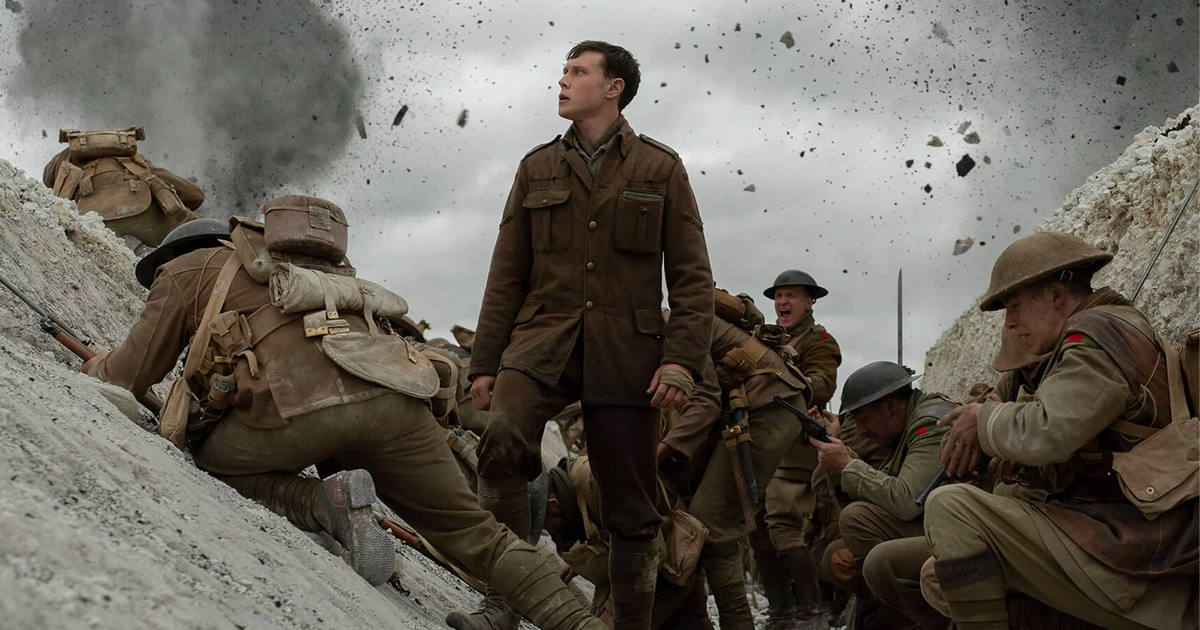
Growing up, director Sam Mendes (Skyfall, American Beauty) had been told stories by his grandfather about his service in World War I. One such story was about his assignment to deliver a message. Although his newest film “1917” does not tell his grandfather’s stories, it was inspired by them. His personal connection to the subject can be felt throughout the film. Although it is technically a war film, 1917 explores a more private journey.
For those who do not know, one of the biggest draws to the film is the challenging cinematography. Mendes brought was set on working with legendary, Academy Award-Winning cinematographer, Roger Deakins (Blade Runner: 2049) to help bring his vision of a war film told in one continuous shot to life. The camera follows the soldiers right into the trenches and across battlefields, often giving the audience a feeling of being placed into the film as an active member of the squad. There are no cuts, just one continuous shot from start to finish.
The film starts in a sea of color – blue skies, green foliage and yellow flowers as the camera tilts down we meet the two young soldiers we are about to follow on their mission, Lance Corporals Schofield (George MacKay) and Blake (Dean-Charles Chapman). They are tasked with saving the lives of 1600 British soldiers by delivering a message off to the Colonel leading a charge on what turns out to be a German trap. As we begin to follow the soldiers into the world of war, the to a palette of grays, browns and tan – desaturated earth tones, devoid of joy and life.
As we tag along with Blake and Schofield it becomes clear that this is not your average war film. Mendes is not focussed on explosions, shrapnel and strategies that usually dominate war films but rather chooses to focus on the human aspect of war. It can be easy to forget that the “warriors” who fought these wars are real people. 1917 reminds us that they were, many just kids. They had families, dreams, love, hopes, and fears. This is easy to forget since most war films reduce the soldiers to cliches or nameless extras. Both Mackay and Chapman really shine here, with performances transcending beyond the role of a hardened soldier, subtly exposing the vulnerabilities, fears and need for companionship that come along with youth.
Mendes is not afraid to sit on a shot where little or nothing is being said by the leads, instead, we are given time to observe how the war has engulfed these boys. In one long “shot” we witness how emotionally and physically drained Schofield. Not much is being said, there are no bullets grazing him, no explosions – only time to take in the how the war has worn him out. We sit co-pilot as they experience a wide array of human emotions (fear, anxiety, doubt, anger, joy, sadness). We travel from the quiet moments of meaningful human interaction found in a shared conversation or meal to the horrors of war filled with death, rotting and destruction.
Tom Newman’s score provides tremendous orchestral power to these visceral experiences. But, at the film’s core, it is the pensive camera work of Roger Deakins that injects humanity into the film. A masterstroke of cinematography. It is never obtrusive nor gimmicky while it certainly would be easy to be so. Through some intricate planning, Mendes/Deakins provides engrossing perspectives that wind us through various types of terrain and scenarios. Some had me awe-struck, others appear straight forward but upon reflecting on it becomes apparent how well designed they truly are.
An example, which captures both, is a nighttime scene which relies only on flares and moonlight to provide illumination. Beautiful dark shadows drape across the terrain creating high contrast swatches that shift and meld as the next flare rises and falls. It has a tranquil, hallucinatory characteristic to it – that is until you remember that this is the middle of a battlefield, and at any moment a bullet end your life. These moments of juxtaposition are when Mendes entrances the audience. We start to find the beauty among the madness.
As a whole, the continuous shot is quite seamless. Only during a couple of transitions could I tell (or I believe I could tell) when the camera stopped and picked up again. Shortly into the film it is quite easily forgotten that this is all meant to be one shot. By doing so, 1917 is completely immersive as we follow the personal journey of the people behind the uniforms.
1917 opens in limited release on Christmas Day, and opens wide on January 10th.

